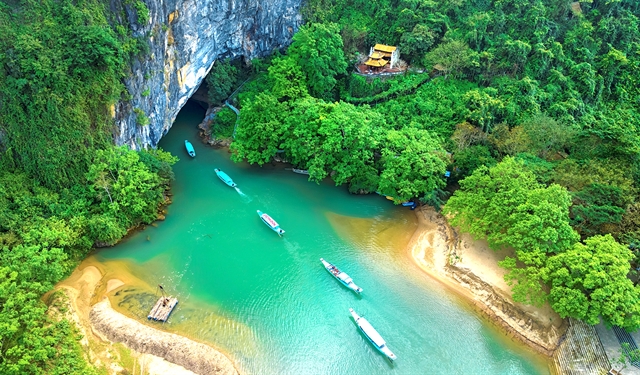 Society
Society

On July 3, 2003, the World Heritage Committee under the United Nations Educational Scientific and Cultural Organisation (UNESCO) approved Việt Nam's submission to recognise the Phong Nha-Kẻ Bàng National Park as a World Natural Heritage Site, with criteria of exceptional global value in terms of geology and geomorphology.

|
| Tourists on boats visiting Phong Nha Cave, Phong Nha-Kẻ Bàng National Park, Quảng Bình Province. — VNA/VNS Photo |
QUẢNG BÌNH — The Phong Nha-Kẻ Bàng National Park in the central province of Quảng Bình has twice been honoured as a World Natural Heritage site.
This is a testament to its unique geomorphology, global tourism value and countless efforts of Việt Nam to increase awareness in the process of international integration.
Over the past two decades, the province has preserved cultural heritage values of the national park toward the goal of sustainable development.
On July 3, 2003, the World Heritage Committee under the United Nations Educational Scientific and Cultural Organisation (UNESCO) approved Việt Nam's submission to recognise the Phong Nha-Kẻ Bàng National Park as a World Natural Heritage Site, with criteria of exceptional global value in terms of geology and geomorphology.
The Government of Việt Nam, with support of international organisations, saw the park expand to more than 123,000 hectares to preserve the largest ancient limestone region in Southeast Asia.
On July 3, 2015, UNESCO members agreed to add the criterion of outstanding value representing the evolutionary and development processes of terrestrial ecosystems, possessing meaningful natural habitats for biodiversity conservation.
Over the years, the park management board has actively cooperated with domestic and foreign organisations to carry out scientific projects in the fields of environment, geology-geomorphology, biodiversity, and culture-history to preserve the heritage for the local socioeconomic development.
Since 2003, experts from the Royal British Cave Association have surveyed and discovered 425 caves in seven areas and systems, of which 389 caves have been measured with a total length of 243 km. The most prominent was the discovery of Sơn Đoòng - the world's largest cave. The site is important in caving research in the region, promoting the image of Việt Nam and Quảng Binh and Phong Nha-Kẻ Bàng around the world.
Phong Nha-Kẻ Bàng National Park has three forms of tourism, including self-exploration, joint venture businesses, and leasing of forest environment services.
Currently, the World Natural Heritage site has 15 different routes possible on a tour that include various combinations of nature exploration, caves, camping, walking, and zip line areas.
The development of tourism services has attracted an increasing number of visitors to the site. In order to ensure both tourism development and sustainable heritage conservation, the park management board is monitoring and assessing the impact of tourism activities on the caves to mitigate negative impacts on the heritage.
Phạm Hồng Thái, Director of Phong Nha-Kẻ Bàng National Park Management Board, said the board will continue to strengthen forest management and protection work, scientific research and rescue of wildlife in order to preserve the outstanding global value of the heritage.
The National Park is a model of "Ecosystem and Biodiversity" with a unique population not found anywhere else on the Earth, an evergreen tropical forest with a 500-year-old cypress species.
The Phong Nha-Kẻ Bàng National Park borders the Hin Nam No National Park of Laos. In line with UNESCO's goal of expanding cooperation in the conservation and preservation of heritage sites, Việt Nam and Laos are working together to build the first inter-country heritage profile in Southeast Asia and the largest continuous karts cross-border heritage in the world. The expansion plans are to be submitted to UNESCO in 2024. — VNS